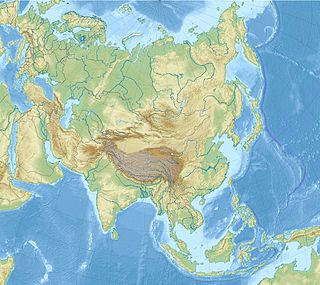 W
WThe Xiongnu were a tribal confederation of nomadic peoples who, according to ancient Chinese sources, inhabited the eastern Eurasian Steppe from the 3rd century BC to the late 1st century AD. Chinese sources report that Modu Chanyu, the supreme leader after 209 BC, founded the Xiongnu Empire.
 W
WThe Inscription on the Ceremonial Mounding of Mount Yanran is an inscription composed by the Eastern Han dynasty Chinese historian Ban Gu and carved by the general Dou Xian on a cliff in the Yanran Mountains in 89 AD, to commemorate Dou's victory against the nomadic Xiongnu empire. The text is in the 5th-century official history Book of Later Han, and the inscription was rediscovered by researchers in the Baruun Ilgen hills located south of Inil/Inel mountain, which is in the Gobi desert of Dundgovi Province, Mongolia.
 W
WThe Ivolga archaeological site is the place of a fortified city of the Xiongnu which was founded in the 3rd century BC and destroyed in the 1st century BC. It is sited in the Selenga Highlands near Ulan-Ude, the capital of the Republic of Buryatia, Russia. It is part of the folklore of this city where the Xiongnu are mixed up with the Huns.
 W
WJin Midi (Chinese: 金日磾; pinyin: Jīn Mìdī, courtesy name Wengshu, formally Marquess Jing of Du, was a prominent official of the Chinese Han Dynasty of Xiongnu ethnicity. He served as coregent early in the reign of Emperor Zhao of Han.
 W
WThe Noin-Ula burial site consist of more than 200 large burial mounds, approximately square in plan, some 2 m in height, covering timber burial chambers. They are located by the Selenga River in the hills of northern Mongolia north of Ulan Bator in Batsumber sum of Tov Province. They were excavated in 1924–1925 by Pyotr Kozlov, who found them to be the tombs of the aristocracy of the Xiongnu; one is an exceptionally rich burial of a historically known ruler of the Xiongnu, Uchjulü-Jodi-Chanuy, who died in 13 CE. Most of the objects from Noin-Ula are now in the Hermitage Museum, while some artifacts unearthed later by Mongolian archaeologists are on display in the National Museum of Mongolian History, Ulan Bator. Two kurgans contained lacquer cups, inscribed with Chinese characters believed to be the names of Chinese craftsmen, and dated September 5 year of Tsian-ping era, i.e. 2nd year BCE.
 W
WThe Ordos culture was a culture occupying a region centered on the Ordos Loop during the Bronze and early Iron Age from the 6th to 2nd centuries BCE. The Ordos culture is known for significant finds of Scythian art and is thought to represent either the easternmost extension of Indo-European Eurasian nomads, such as the Saka, or to represent a culture formed by Turkic peoples. Under the Qin and Han dynasties, from the 6th to 2nd centuries BCE, the area came under at least nominal control of contemporaneous Chinese states.
 W
WTongwancheng was the capital of the Xia kingdom, a kingdom founded by the Xiongnu in northern China during the Sixteen Kingdoms period in the early 5th century. The city is at the southern edge of the Maowusu Sands of the Ordos Desert, on what was formerly a strategic site in the center of the Ordos Plateau. Tongwancheng, which means the "city ruling ten thousand", is the largest urban center of the Southern Xiongnu that has ever been found. The city's ruins are well preserved and located in Jingbian County, Shaanxi Province, near the border with Inner Mongolia. The city has been surveyed and has had some elements restored, but not yet fully excavated.
 W
WTouman, Teoman, or T'u-man, is the earliest named Xiongnu chanyu (匈奴單于), reigning from c. 220–209 BCE.
 W
WWang Qiang, commonly known by her courtesy name Wang Zhaojun was known as one of the Four Beauties of ancient China. Born in Baoping Village, Zigui County in the Western Han dynasty, she was sent by Emperor Yuan to marry Chanyu Huhanye of the Xiongnu Empire in order to establish friendly relations with the Han dynasty through marriage.
 W
WYueban, colloquially: "Weak Xiongnu", was the name used by Chinese historians for remnants of the Northern Xiongnu in Zhetysu, now part of modern-day Kazakhstan. In Chinese literature they commonly called Yueban. The Yuebans gained their own visibility after disintegration of the Northern Xiongnu state, because unlike the main body of the Northern Xiongnu, who escaped from the Chinese sphere of knowledge, the Yueban tribes remained closer to China.
 W
WThe Han Zhao, or Former Zhao, was a dynasty of Southern Xiongnu origin during Sixteen Kingdoms period of Chinese history coeval with the Sima clan's Jin dynasty. In Chinese historiography, it was given two conditional state titles, the Northern Han for the state proclaimed in 304 by Liu Yuan, and the Former Zhao for the state proclaimed in 319 by Liu Yao. The reference to them as separate states should be considered misleading, given that when Liu Yao changed the name of the state from "Han" to "Zhao" in 319, he treated the state as having been continuous from the time that Liu Yuan founded it in 304; instead, he de-established royal lineage from the Han dynasty and claimed ancestry directly from Yu the Great of the Xia dynasty.